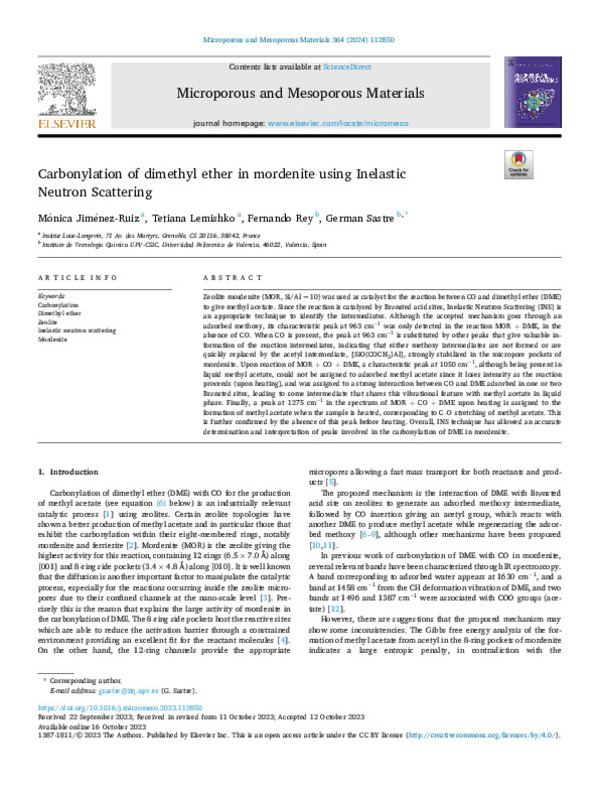JavaScript is disabled for your browser. Some features of this site may not work without it.
Buscar en RiuNet
Listar
Mi cuenta
Estadísticas
Ayuda RiuNet
Admin. UPV
Carbonylation of dimethyl ether in mordenite using Inelastic Neutron Scattering
Mostrar el registro sencillo del ítem
Ficheros en el ítem
| dc.contributor.author | Jiménez-Ruiz, Mónica
|
es_ES |
| dc.contributor.author | Lemishko, Tetiana
|
es_ES |
| dc.contributor.author | Rey Garcia, Fernando
|
es_ES |
| dc.contributor.author | SASTRE NAVARRO, GERMAN IGNACIO
|
es_ES |
| dc.date.accessioned | 2024-04-11T11:50:12Z | |
| dc.date.available | 2024-04-11T11:50:12Z | |
| dc.date.issued | 2024-01-15 | es_ES |
| dc.identifier.issn | 1387-1811 | es_ES |
| dc.identifier.uri | http://hdl.handle.net/10251/203420 | |
| dc.description.abstract | [EN] Zeolite mordenite (MOR, Si/Al =10) was used as catalyst for the reaction between CO and dimethyl ether (DME) to give methyl acetate. Since the reaction is catalysed by Bronsted acid sites, Inelastic Neutron Scattering (INS) is an appropriate technique to identify the intermediates. Although the accepted mechanism goes through an adsorbed methoxy, its characteristic peak at 963 cm-1 was only detected in the reaction MOR + DME, in the absence of CO. When CO is present, the peak at 963 cm-1 is substituted by other peaks that give valuable in-formation of the reaction intermediates, indicating that either methoxy intermediates are not formed or are quickly replaced by the acetyl intermediate, [SiO(COCH3)Al], strongly stabilised in the micropore pockets of mordenite. Upon reaction of MOR + CO + DME, a characteristic peak at 1050 cm-1, although being present in liquid methyl acetate, could not be assigned to adsorbed methyl acetate since it loses intensity as the reaction proceeds (upon heating), and was assigned to a strong interaction between CO and DME adsorbed in one or two Bronsted sites, leading to some intermediate that shares this vibrational feature with methyl acetate in liquid phase. Finally, a peak at 1275 cm-1 in the spectrum of MOR + CO + DME upon heating is assigned to the formation of methyl acetate when the sample is heated, corresponding to C-O stretching of methyl acetate. This is further confirmed by the absence of this peak before heating. Overall, INS technique has allowed an accurate determination and interpretation of peaks involved in the carbonylation of DME in mordenite. | es_ES |
| dc.description.sponsorship | We thank CTI-CSIC for computational facilities. We thank ILL for neutron beam-time allocation (experiment 7-05-470). Financial support by the Spanish Ministry of Science and Innovation (CEX2021-001230-S grant funded by MCIN/AEI/10.13039/501100011033 funded by "ERDF A way of making Europe" and TED2021-130191B-C41 grant funded by the European Union NextGenerationEU/PRTR) are gratefully acknowledged. Authors thank also the financial support by Generalitat Valenciana (Prometeo 2021/077). This study forms part of the Advanced Materials programme and was supported by MCIN with partial funding from European Union Next Generation EU (PRTR-C17. I1) and by Generalitat Valenciana (MFA/2022/047). | es_ES |
| dc.language | Inglés | es_ES |
| dc.publisher | Elsevier | es_ES |
| dc.relation.ispartof | Microporous and Mesoporous Materials | es_ES |
| dc.rights | Reconocimiento (by) | es_ES |
| dc.subject | Carbonylation | es_ES |
| dc.subject | Dimethyl ether | es_ES |
| dc.subject | Zeolite | es_ES |
| dc.subject | Inelastic neutron scattering | es_ES |
| dc.subject | Mordenite | es_ES |
| dc.title | Carbonylation of dimethyl ether in mordenite using Inelastic Neutron Scattering | es_ES |
| dc.type | Artículo | es_ES |
| dc.identifier.doi | 10.1016/j.micromeso.2023.112850 | es_ES |
| dc.relation.projectID | info:eu-repo/grantAgreement/GVA//PROMETEO%2F2021%2F077/ | es_ES |
| dc.relation.projectID | info:eu-repo/grantAgreement/AEI//TED2021-130191B-C41//Ayudas públicas a proyectos estratégicos orientados a la transición ecológica y a la transición digital, convocatoria 2021/ | es_ES |
| dc.relation.projectID | info:eu-repo/grantAgreement/MICINN//CEX2021-001230-S/ | es_ES |
| dc.relation.projectID | info:eu-repo/grantAgreement/MICINN//PRTR-C17.I1/ | es_ES |
| dc.relation.projectID | info:eu-repo/grantAgreement/CIUCSD//MFA%2F2022%2F047/ | es_ES |
| dc.rights.accessRights | Abierto | es_ES |
| dc.description.bibliographicCitation | Jiménez-Ruiz, M.; Lemishko, T.; Rey Garcia, F.; Sastre Navarro, GI. (2024). Carbonylation of dimethyl ether in mordenite using Inelastic Neutron Scattering. Microporous and Mesoporous Materials. 364. https://doi.org/10.1016/j.micromeso.2023.112850 | es_ES |
| dc.description.accrualMethod | S | es_ES |
| dc.relation.publisherversion | https://doi.org/10.1016/j.micromeso.2023.112850 | es_ES |
| dc.type.version | info:eu-repo/semantics/publishedVersion | es_ES |
| dc.description.volume | 364 | es_ES |
| dc.relation.pasarela | S\508707 | es_ES |
| dc.contributor.funder | Generalitat Valenciana | es_ES |
| dc.contributor.funder | Agencia Estatal de Investigación | es_ES |
| dc.contributor.funder | European Regional Development Fund | es_ES |
| dc.contributor.funder | Ministerio de Ciencia e Innovación | es_ES |
| dc.contributor.funder | Conselleria de Innovación, Universidades, Ciencia y Sociedad Digital, Generalitat Valenciana | es_ES |








